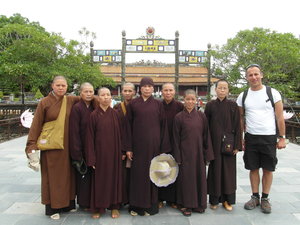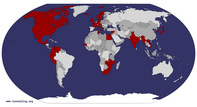Advertisement
Published: July 25th 2012

 Hue Citadel
Hue Citadel
With some Buddhist nunsDear All
Hello from Central Vietnam, second update of my trip so far, and having (as usual!) the most amazing time! What a country, and what lovely people! They really make you feel welcome here, and smiles abound wherever you go – and not those which are given to make a tourist dollar or two. These are genuine, heartfelt smiles and I have been initiating and reciprocating them wherever I go – they’re contagious! I must admit it’s rather noisy and hectic with the traffic in general (if you’ve seen my video uploaded onto my Facebook page, you’ll know what I mean!), but aside from this minor detraction, this really is an amazing, welcoming and lovely country, and I’m certainly having a great time of it.
Writing this entry from my most comfortable room so far. They all have been great so far, but this one really takes the biscuit – it is like a mini-palace, with an eighth-floor view north over the Perfume River and the Royal Citadel and Forbidden City of the Vietnamese Emperors of the 19
th Century Nguyen dynasty, in a lovely city called Hue. The room is full of darkwood, carved and polished furniture, and
with a hardwood floor to match it’s just stunning (as is the very economical price tag, not breaking my budget of £20 per night)
Since I last wrote I’ve moved myself towards the centre of the country, by flying (nearly missing due to a last-minute change to the boarding gate which was not displayed on the departure screen) Vietnam Airlines from Saigon to Danang, and meeting fellow Spanish travellers Nacho and Mili for the third time so far this trip (I met them again yesterday for the 4
th time in Hoi An!) on board. Thankfully a smooth flight, compared to the nightmare which was my landing in Saigon. Though looking at the weather forecast for the region, there seems to be a tropical cyclone called Vicente passing over Vietnam from Hong Kong as we speak. It made landfall on Northern Vietnamese soil yesterday evening, and made for a very windy start to the day this morning. It will hopefully have passed over Northern Vietnam in time for my arrival in Hanoi on Thursday…
So these last few days have been spent checking out the sights of Central Vietnam, and what a great deal there is to see here.
This region has so much potential for tourism development in the near future, it simply has everything: a big city, old imperial/medieval towns, offshore tropical islands, diving spots, an old French colonial hill station, Cham ruins and lots of Vietnam War reminders. In my few days here I feel I have only just skimmed the surface. I definitely recommend it to anyone looking for a beach holiday with a difference – there’s just so much here, and it’s great to see things developing so quickly and efficiently for the Vietnamese, and by the Vietnamese.
First day upon arrival, on Saturday, I stayed the night in Danang, the region’s main city at one million people, though relatively free of tourists and touristy places. This already was a nice breath of fresh air after staying in the traveller enclave of Saigon for 4 nights. The people there were super friendly, including a memorable visit to the local Food Court with 6 or so cashier girls giggling amongst themselves and looking at me as I was about to pay, when one of them said to me “my friend think you very handsome”, with a further outburst of giggles – that just made
my day!! I also fitted in a trip to the nearby China Beach, of legendary Vietnam War fame as the first landing point for US soldiers in 1965. Completely geared out for a full-on battle with the Viet Cong, the soldiers were most surprised to be greeted by local girls and garlands of flowers in welcome, as unfortunately the history books seem to forget that the US army arrived in the first place to protect the anti-communist South of Vietnam against their northern aggressors. A lovely sweep of beach remains to this day, hiding the ghosts of the past rather impressively.
On Sunday I caught a sleeper bus for the one-hour journey south to Hoi An – sleeper, as the bus was continuing southwards towards Saigon (around 23 hours further…!). So it was a bit odd to travel like this, and also the first time I’ve seen such a bus – instead of the usual upright seats, there are three lines and two storeys of “seats” which recline until they’re almost flat, and two very narrow aisles between them. Rather strange to see for the first time, but what a great idea! I’m still happy to be flying the

 Danang
Danang
Han River viewlong distances though (as long as I hit no typhoons of course…!)
Two days in Hoi An, a delightful little medieval town dating back to the time of Chinese and Japanese merchants who first started setting up shop there in the 15
th Century, trading in tea, porcelain, pepper, ivory and textiles, amongst other goods. Today its old-world, oriental heritage is perfectly preserved, and a wander around the old town with its lovely little river running through the middle was seriously like stepping back in time. There are lots of temples and old trading houses to visit, interspersed with boutiques, art galleries and lovely little cafes and restaurants. A delight! It was also the location for a fair portion of the film “The Quiet American”, which is set in Saigon but I guess used Hoi An for its greater historical authenticity – I’ll have to watch the film again when I get home.
Yesterday morning I also managed to fit in a visit to nearby My Son, former religious centre of the Champa kingdom founded in the 4
th Century AD. The Chams (based in Central Vietnam) were the Vietnamese’s (originally based in Northern Vietnam) major rivals (along with the

 Danang
Danang
Han RiverChinese to the north), until the former’s defeat at the latter’s hands in the 15
th Century. And similar to the Khmers of modern-day Cambodia, they practised a form of Hinduism focusing on the Hindu deity Shiva. Though nowhere near as impressive as Angkor Wat in Cambodia, the Cham ruins here were rather splendid, set in a lush valley surrounded by jungle, streams and mountains, with a number of interesting Hindu reliefs carved into the stones.
And then finally on Tuesday caught a bus to here, beautiful Hue. A stunningly sited majestic former royal capital of the Nguyen dynasty, who ruled from here to unite the north and south of the country during the 19
th century. Spent the morning exploring the Imperial Enclosure of the Citadel, which seems to have been modelled on the Forbidden City in China, the Vietnamese having taken much of their political and administrative know-how from the historically volatile relationship with their northern neighbours. Unfortunately, during the infamous 1968 Tet Offensive of the Vietnam War, in which the Viet Cong took Hue for 3 and a half weeks before the Americans re-captured it (the citizens not having welcomed the invading communists in the slightest) most of
the former glory of the Citadel was bombed and destroyed. What remains today are 20 of the 148 buildings in total, still sparking of an era of majestic and proud Vietnamese imperialism, which the country seems to be very proud of today despite Ho Chi Minh’s pressurised abdication of the last Vietnamese Emperor, Bao Dai, in 1945 following Vietnamese self-proclaimed independence from the Japanese and the French. Still, the remaining buildings are stunning, and a glimpse of the glories of 19
th Century imperial Vietnam.
And finally, spent the afternoon hiring a “xe om”, or motorbike-cum-taxi, to take me round a couple of sights just outside the city. First up, the most impressive of the Nguyen Emperors’ royal tombs, the Mausoleum of Emperor Tu Duc. The compound holds not only the tomb of Tu Duc, but that of close members of his family, and a number of temples and pagodas, all set beautifully around a lily-filled body of water interspersed by a mini-forest of trees – beyond the tour groups, it was a most tranquil setting. And then after this, a visit to Vietnam’s most iconic monastery, the Thien Mu Pagoda. It is here where Buddhist political demonstrations against a
number of government-moves have taken shape over the last half-century, and today it even houses the very Austin motorcar which appears in the background of the photo of the self-immolation of Vietnamese monk Thich Quang Duc. You may have seen the photo, dramatic and horrific, showing Thich having been driven in the car to a busy intersection of Saigon in 1963, pouring petrol over himself and setting himself alight. This was in protest at the anti-Buddhist policies of the unpopular Catholic president of South Vietnam at the time, a certain Ngo Dinh Diem. The car was of particular interest to me as this last year I have included the monk’s story in an RS lesson on self-sacrifice and martyrdom, in which the monk’s self-immolation sparked several other monks to do the same. Along with the callous comments of the president’s sister-in-law, Madame Nhu, who referred to the protests as a “barbecue party” and stated “let them burn and we shall clap our hands”, the self-immolations led to a military coup a few months later which saw the president assassinated. In a way, the monk’s self-sacrifice earned his desire for greater political and religious freedom in the country with the ousting
of the unpopular president, but was unfortunately overshadowed by the terrible proceedings as the communist north sought to expand its influence in the south shortly after.
So here it is that my journey has led me, and where I shall be shortly wrapping up this entry. Tomorrow I fly further north to Hanoi, where I plan to spend a couple of days before heading out to the famous Halong Bay, for stunning tropical coastal scenery. Hoping that all will go to plan, as Typhoon Vicente over the last few days has caused significant transport disruption in the north of the country. But alas, if it does not, what is meant to be will be – I am looking forward to whatever lies in store next on this amazing journey.
Thanks for reading, and until the next time.
Alex
Advertisement
Tot: 0.073s; Tpl: 0.016s; cc: 12; qc: 29; dbt: 0.0203s; 1; m:domysql w:travelblog (10.17.0.13); sld: 1;
; mem: 1.1mb
























